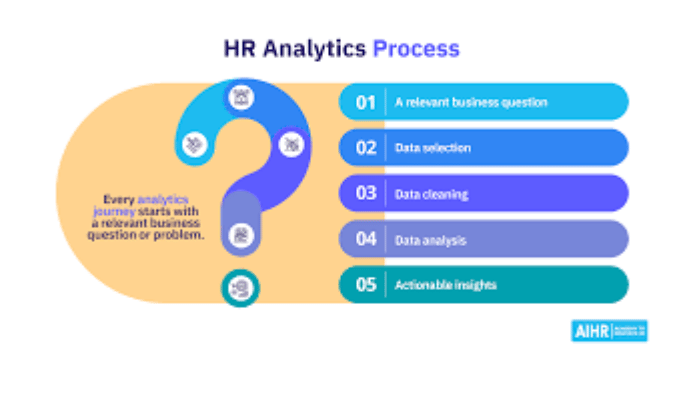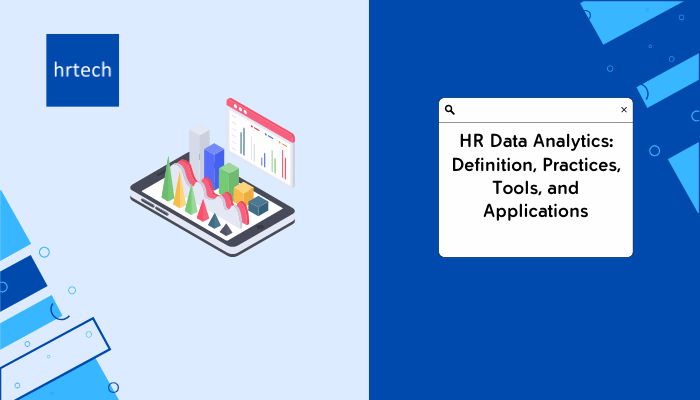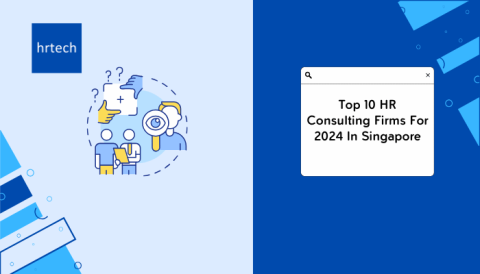In the fast-paced world of human resources, juggling a myriad of tasks is simply par for the course. From recruitment and retention to staying abreast of the latest industry trends, the critical role of data analysis often finds itself relegated to the back burner.
However, what if I were to reveal that HR data analytics is the key to unlocking a more strategic, data-driven approach to people management?
The truth is, HR data is a veritable goldmine of insights waiting to be unearthed, offering the potential to inform decisions that drive tangible business results, from enhancing employee engagement to optimizing talent acquisition.
But where does one even begin in harnessing this wealth of information?
In today’s data-driven business landscape, HR transcends traditional notions of simply hiring and firing. It’s about harnessing the wealth of information at your disposal to construct a strategic, data-driven HR function that can propel your organization forward.
It’s fascinating to note that HR departments equipped with robust analytics capabilities experience a remarkable 25% increase in productivity, underscoring the transformative power of data in shaping the future of HR.
So, let’s embark on an exploration into the depths of HR data analytics to uncover the untapped potential that lies within
Introduction:

What is HR Data Analytics?
In simpler terms, HR data analytics is the art and science of collecting, analyzing, and interpreting HR data to gain valuable insights into your workforce. It’s about moving beyond gut feelings and making data-driven decisions that improve critical areas like recruitment, retention, performance Management, Learning & Development.
Traditionally, HR relied on intuition and experience to make decisions. However, the digital age has ushered in a data revolution. The abundance of HR data has paved the way for a more strategic approach to HR management.
In today’s complex business environment, data-driven decision-making is no longer a luxury, it’s a necessity. HR analytics empowers HR professionals to:
Move beyond gut feelings: Data provides concrete evidence to support HR decisions, leading to more effective outcomes.
Demonstrate ROI: By quantifying the impact of HR initiatives, HR can gain a seat at the strategic table and secure budget allocations.
Predict future trends: Data analysis helps HR anticipate workforce needs, skills gaps, and potential challenges.
Build a culture of data-driven decision-making: By embracing data, HR can foster a data-centric culture throughout the organization.
Applications Of HR Data Analytics:
1. How HR Analytics is Applied Across Various HR Functions
HR data analytics isn’t a one-trick pony. It can be applied strategically across various HR functions to bring about significant improvements. Here are some key areas:
Talent Acquisition: Imagine pinpointing the ideal candidate profile based on past high performers. Data analytics can help you identify the best sources for talent, predict time-to-hire, and optimize your recruitment strategies.
Performance Management: Ditch the annual review black box. HR analytics allows you to track key performance indicators (KPIs) in real-time, providing valuable insights for ongoing feedback and development conversations.
2. Exploring Applications in Specific Areas:
Let’s delve deeper into some specific applications of HR data analytics
Employee Turnover Patterns: Predict flight risks by analyzing employee data points like demographics, performance reviews, and compensation. This allows you to implement proactive retention strategies and save on costly replacements.
Recruitment Assessment: Go beyond resumes! Data analytics can help you develop more effective assessments by analyzing past performance data and tailoring interview questions to identify the best fit for the role.
Talent Management: Unleash the full potential of your workforce. Data can help you identify high-potential employees, create personalized development plans, and build strong succession pipelines.
3. Using HR Analytics for Strategic Initiatives:
The power of HR data analytics extends beyond everyday operations. Here’s how it can fuel strategic decision-making
Training and Development: Identify skill gaps across your workforce and tailor training programs to address them precisely. Data can also help you measure the effectiveness of training initiatives and ensure your investment yields a strong return.
Compensation Optimization: Ensure fair and competitive compensation by analyzing salary trends across your industry and within your organization. HR data analytics can help you identify pay gaps and optimize compensation packages to retain top talent.
Predicting Future Workforce Needs: Stay ahead of the curve by using data to forecast future skill demands and workforce trends. This proactive approach allows you to develop targeted talent acquisition strategies and upskilling programs to ensure you have the right people in place for future success.
Transforming HR through Agile Workforce Solutions
Importance of HR Data Analytics:

HR is no longer just about paperwork and payroll. By embracing data analytics, HR becomes a strategic partner that drives business results. Data empowers you to move beyond basic administration and demonstrate the tangible impact of your HR initiatives.
Are your HR policies working as intended? Data analytics provides the key to measuring the effectiveness of your initiatives. You can track trends, identify unintended consequences, and ensure your HR strategies align with your overall business goals.
The Benefits of Engaging in HR Analytics, Including Better Decision-Making and Uncovering Inefficiencies:
Imagine making data-driven decisions that improve recruitment, reduce turnover, and optimize training programs. That’s the power of HR data analytics! By analyzing data, you can uncover hidden inefficiencies, identify areas for improvement, and make informed decisions that benefit both your employees and your organization. Here are some additional benefits:
Reduced Costs: Data analytics can help you identify areas of waste, streamline processes, and optimize resource allocation, leading to significant cost savings.
Improved Employee Experience: By understanding employee needs and preferences through data, you can create a more positive and engaging work environment that boosts morale and productivity.
Enhanced Employer Branding: Data can help you identify what attracts top talent and allows you to tailor your employer branding strategy to attract the best and brightest.
HR Data Analytics Tools:
The world of HR data analytics offers a diverse range of tools, each with its own strengths and functionalities. Here’s a quick glimpse at some of the most common players:
- Spreadsheets (Excel): A familiar friend for many, Excel can be a great starting point for basic data analysis and visualization. It’s user-friendly and readily available, but its capabilities can become limited for complex datasets.
- Statistical Software (R, Python): For those comfortable with coding, R and Python offer robust functionalities for advanced data analysis and statistical modeling. However, they require a steeper learning curve.
- Data Visualization Tools (Power BI, Tableau): These user-friendly platforms excel at creating interactive dashboards and reports that bring your data to life with clear and compelling visuals.
- HR-Specific Analytics Platforms (Visier, Qlik): These specialized tools cater specifically to HR data needs, offering pre-built dashboards, industry benchmarks, and intuitive interfaces for HR professionals.
- Other Tools (SPSS, CPLEX Optimizer): SPSS offers powerful statistical analysis capabilities for those with research backgrounds. CPLEX Optimizer delves into the realm of optimization, helping you make data-driven decisions for complex staffing scenarios.
Choosing the Right Tool Based on Goals, Analysis Type, and Data Work Requirement:
The ideal tool depends on your specific needs and goals. Here are some factors to consider when making your choice:
- Technical Expertise: Consider your team’s comfort level with data analysis and coding.
- Data Volume and Complexity: For larger, more complex datasets, you’ll need a robust tool with advanced functionalities.
- Desired Outputs: Are you looking for basic reporting, interactive dashboards, or sophisticated statistical analysis?
- Budget: HR-specific platforms often come with subscription fees, while open-source options like R and Python are free to use.
Remember: The best tool is the one that empowers you to extract valuable insights from your data and translate them into actionable strategies. Don’t be afraid to explore different options and find the one that best suits your needs.
Key HR Metrics:
Understanding your workforce is crucial, and HR data metrics are the key performance indicators (KPIs) that provide valuable insights. Common metrics include:
Employee Turnover: Measures the rate at which employees leave the organization. Knowing this helps you identify areas to improve retention.
Absenteeism: Tracks employee absences, unplanned or planned. High absenteeism can indicate low morale or scheduling issues.
Revenue per Employee: This metric reveals the contribution of each employee to the organization’s revenue generation.
Cost per Hire: Understanding the cost of recruiting and onboarding new employees helps you optimize your recruitment process.
These are just a few examples, and the right metrics for you will depend on your specific goals.
Implementing HR Data Analytics
Ready to harness the power of data? Here’s a simplified roadmap to get you started:
Ask the Right Questions: Start by identifying your HR challenges and business goals. What questions can data answer to help you achieve them?
Data Selection and Cleaning: Gather relevant data from various HR systems. Ensure the data is accurate and complete before analysis.
Data Analysis: Use your chosen tools to analyze the data, identify trends, and uncover hidden insights.
Actionable Insights: Translate your findings into practical recommendations and strategies to improve your HR practices.
Advancing HR Data Analytics Practices:
We’ve covered the essentials, but there’s always room to grow! This section dives into advanced concepts to help you refine your HR data analytics practice:
Move beyond simply describing what’s happening with your workforce. Leverage advanced analytics to predict future trends and prescribe actions. Imagine forecasting potential talent gaps or identifying employees at risk of flight. This proactive approach empowers you to make informed decisions that shape the future of your organization.
How effectively are you leveraging HR data analytics? Evaluate your current maturity level and identify areas for improvement. Consider factors like data accessibility, talent skillsets, and established processes. Based on your assessment, develop a strategic roadmap to enhance your HR analytics capabilities.
Best Practices in HR Data Analytics:
Here are some key practices to ensure you’re getting the most out of your HR data analytics journey:
Requiring Data-Based Decision-Making Within HR Functions:
Shift the mindset! Embed data-driven decision making throughout your HR function. Encourage a culture where data informs discussions, strategies, and resource allocation.
Finding the Right Mix of Analytical Tools and Asking Data-Driven Questions:
Don’t get caught up in the latest tech. Choose the right tools that fit your needs and skillset. More importantly, cultivate a culture of asking data-driven questions. What are you trying to achieve? What insights will move the needle?
Transforming Data into Actionable Insights and Gaining Leadership Buy-In:
Data is powerful, but it needs translation. Develop clear and concise reports and visualizations that communicate insights effectively. This fosters leadership buy-in and ensures your data-driven recommendations are implemented for maximum impact.
Conclusion:
HR data analytics is a powerful tool waiting to be harnessed. By leveraging the insights it provides, you can make data-driven decisions, optimize HR processes, and ultimately build a stronger, more successful workforce.
Don’t wait! Subscribe to our newsletter for ongoing HR data analytics tips and tricks, or schedule a call with our Hrtech specialists to take your HR strategy to the next level. The future of HR is driven by data, and we’re here to help you navigate the exciting journey ahead!





